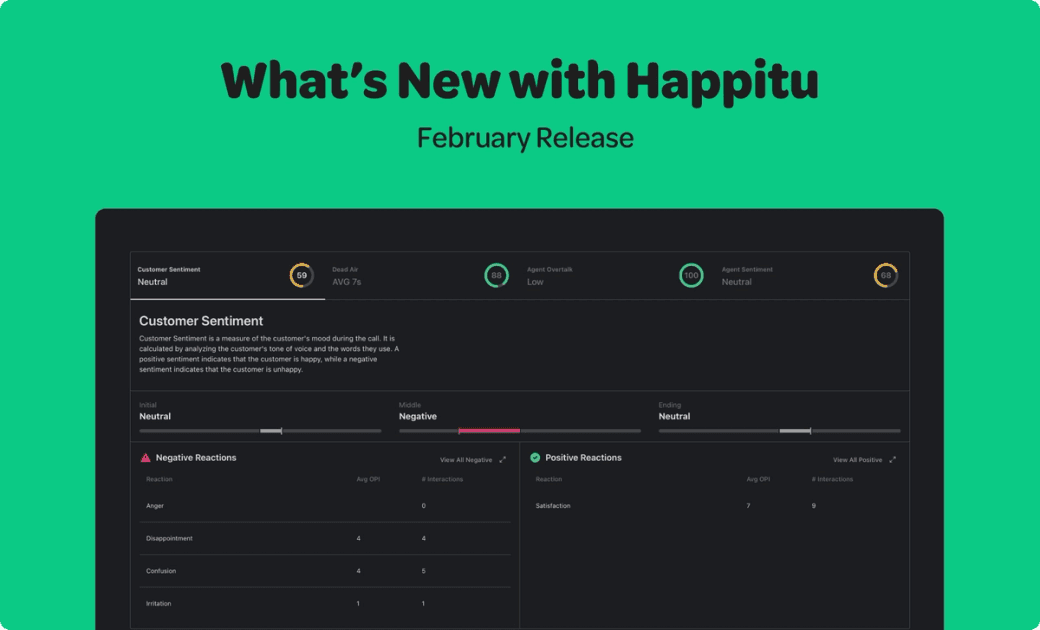What is it?
Simply put, speech analytics is the automated process of analyzing conversations. Using Natural Language Processing (NLP), Artificial Intelligence (AI), and Machine Learning (ML), speech analytics can instantly identify a wide variety of customer-impacting issues. Customer contact centers (call centers if you’re old-school!) increasingly employ these solutions to surface information from customer interactions to improve future customer experiences.
How does it work?
For customer calls, speech analytics begins with a transcription of a conversation using automatic speech recognition technology. The transcript is then analyzed to surface things like the topic(s) of the conversation, emotional states, breaks in the conversation, and regulatory compliance, among others. This information can be presented as a dashboard to contact center leadership to identify opportunities in real-time. In an omnichannel contact center, customer conversations over channels like chat are, by nature, already transcribed, but can still be analyzed like phone conversations. This is sometimes referred to as text analytics as opposed to voice analytics.
How does it benefit a company?
While speech analytics tools were once primarily used by only the largest contact centers, today, even small businesses with only a handful of people answering the phone can easily implement cost-effective solutions. The benefits of speech analytics solutions can be broken down into two main categories - agent performance and customer insights.
Agent Performance
A typical contact center uses human review of call recordings to measure agent performance and identify coaching opportunities for contact center agents. This review is often referred to as a Quality Evaluation or Quality Assurance. Using automation to supplement or replace human-executed Quality Evaluations solves two main problems: sample size and bias.
The Sample Size Problem
When relying on humans for quality management efforts, most contact centers can only evaluate 1-2% of all recorded calls. That means up to 99% of calls are ignored. Some small businesses don’t have anyone listening to calls to monitor performance meaning 100% of calls are ignored.
This is particularly dangerous when dealing with regulatory compliance issues that could subject your company to large fines. You need to know if your agents are handling these issues correctly on every call because one mistake could cost you thousands of dollars.
Is your sales team attempting to overcome objections on every sales opportunity? If you’re using humans for quality management, you likely have no idea how many lost sales opportunities are simply due to not following the sales process.
By using speech analytics solutions, you can evaluate up to 100% of calls instantly. This functionality allows contact center leaders can easily identify consistent gaps in performance, allowing them to perform targeted coaching, ensuring compliance and driving revenue.
The Bias Problem
Humans are inherently biased and first-time managers often struggle to separate their subjective opinion about agent performance from the objective facts, leading to inconsistent coaching. Inconsistent coaching not only negatively impacts performance, but can lead to agent churn. Agent churn means more hiring which impacts operational efficiency.
Using speech analytics can remove bias, surfacing objective performance opportunities on each and every call. This allows supervisors to focus on coaching the right behaviors to improve customer satisfaction and agent performance.
Customer Insights
There’s a heavy reliance on Voice of the Customer survey metrics like CSAT and NPS to understand how customers “feel” about companies. The problem is that these metrics rely on customers who are willing to provide feedback and typically present a skewed assessment because many customers simply choose not to participate.
But speech analytics, and more specifically, sentiment analysis, uses the literal voice of the customer to determine customer sentiment. It can also surface call drivers, mentions of competitors, supervisor escalations, and much more. Your customers provide actionable insights every day that can be unlocked using speech analytics software.
Who knew you could improve the customer relationship and the employee experience just by employing new technology? Well, we did, and that’s why we’re sharing it with you.
Costs of implementing it
While there are many use cases for using speech analytics, cost has historically been a barrier. But like all technologies, the cost is decreasing while the quality is increasing. For most organizations, size is the primary driver of cost. Some pricing models account for the number of agents you have, often referred to as “seats” while others rely solely on the volume of conversations being analyzed, often called “metered”. In either model, the cost to implement will be highly variable.
But there are other potential costs to consider. Is there a monthly or annual minimum? Is there a setup fee? Are there costs for support? Are there additional integration costs to tie into business systems already in place like your ACD or CRM?
Be sure to ask potential providers about all their costs and what kind of commitment is required on your part. Be wary of contractual obligations that don’t flex with your business.
Getting started
Reputable partners will start with a demonstration of their system. Upon request, they’ll provide a complimentary Proof of Concept (POC) using a sample of your recorded calls.
If testing what speech analytics can do for your organization is one of your current initiatives, we’d love to show you how Happitu Vision can can provide you business intelligence that drives contact center performance you never dreamed possible! Whether you have 3 agents or 300 agents, Happitu Vision is the easiest way to see every customer interaction - let us prove it!



